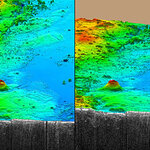Science category landing
Earth Sciences

Taking a page from nature, a team of researchers have developed a method to enhance removal of carbon dioxide from the atmosphere and place it in the Earth's oceans for storage.
Unlike other proposed ocean sequestration processes, the new technology does not make the oceans more acid and may be beneficial to coral reefs. The process is a manipulation of the natural weathering of volcanic silicate rocks.
"The technology involves selectively removing acid from the ocean in a way that might enable us to turn back the clock on global warming," says Kurt Zenz House, graduate student in Earth and…

As sea levels rise, coastal communities could lose up to 50 percent more of their fresh water supplies than previously thought, according to a new study from Ohio State University.
Hydrologists here have simulated how saltwater will intrude into fresh water aquifers, given the sea level rise predicted by the Intergovernmental Panel on Climate Change (IPCC). The IPCC has concluded that within the next 100 years, sea level could rise as much as 23 inches, flooding coasts worldwide.
Scientists previously assumed that, as saltwater moved inland, it would penetrate underground only as far as it…

The radar system on ESA’s Mars Express has uncovered new details about some of the most mysterious deposits on Mars: The Medusae Fossae Formation. It has given the first direct measurement of the depth and electrical properties of these materials, providing new clues about their origin.
The Medusae Fossae Formation (MFF) are unique deposits on Mars. They are also an enigma. Found near the equator, along the divide between the highlands and lowlands, they may represent some of the youngest deposits on the surface of the planet. This is inferred from the marked lack of impact craters dotting…

Britain could throw away a lead in biopesticides because of outmoded styles of regulation, researchers at a University of Warwick conference have warned today.
Biopesticides – Green pest control using natural predators such as insects, fungi and bacteria – are the subject of a conference for scientists and industry experts at the University of Warwick this week ‘Biopesticides, the Regulatory Challenge’.
Professor Wyn Grant has led a three-year project with researchers at Warwick HRI looking at biological alternatives to chemical pesticides. He said: “Globally the biopesticides market is…

A series of monumental volcanic eruptions in India may have killed the dinosaurs 65 million years ago, not a meteor impact in the Gulf of Mexico. The eruptions, which created the gigantic Deccan Traps lava beds of India, are now the prime suspect in the most famous and persistent paleontological murder mystery, say scientists who have conducted a slew of new investigations honing down eruption timing.
"It's the first time we can directly link the main phase of the Deccan Traps to the mass extinction," said Princeton University paleontologist Gerta Keller. The main phase of the Deccan…

Soils may dictate the array of fall colors as much as the trees rooted in them, according to a forest survey out of North Carolina.
By taking careful stock and laboratory analyses of the autumn foliage of sweetgum and red maple trees along transects from floodplains to ridge-tops in a nature preserve in Charlotte, N.C., former University of North Carolina at Charlotte graduate student Emily M. Habinck found that in places where the soil was relatively low in nitrogen and other essential elements, trees produced more red pigments known as anthocyanins.
Habinck's discovery supports a 2003…

Agricultural soil erosion is not a source of carbon dioxide to the atmosphere, according to research published in Science. The study was carried out by an international team of researchers from UC Davis, the Catholic University of Leuven in Belgium, and the University of Exeter in the U.K.
Carbon emissions are of great concern worldwide because they, and other greenhouse gases, trap heat in the Earth's atmosphere and are a major cause of global climate change.
"There is still little known about how much carbon exactly is released, versus captured, by different processes in terrestrial…

A team of scientists led by a researcher at the University of Alaska Fairbanks has identified a new likely source of a spike in atmospheric methane coming out of the North during the end of the last ice age.
Methane bubbling from arctic lakes could have been responsible for up to 87 percent of that methane spike, said UAF researcher Katey Walter, lead author of a report printed in the Oct. 26 issue of Science magazine. The findings could help scientists understand how current warming might affect atmospheric levels of methane, a gas that is thought to contribute to climate change.
“It tells…

Global temperatures predicted for the coming centuries may trigger a new ‘mass extinction event’, where over 50 per cent of animal and plant species would be wiped out, warn scientists at the Universities of York and Leeds.
The research team has, for the first time, discovered a close association between Earth climate and extinctions in a study that has examined the relationship over the past 520 million years – almost the entire fossil record available.
Matching data sets of marine and terrestrial diversity against temperature estimates, evidence shows that global biodiversity is…

Human activities are releasing carbon dioxide faster than ever, while the natural processes that normally slow its build up in the atmosphere appear to be weakening, according to a new report. The report states that “together, these effects characterize a carbon cycle that is generating stronger-than-expected climate forcing sooner than expected.”
Between 2000 to 2006, human activities such as burning fossil fuels, manufacturing cement, and tropical deforestation contributed an average of 4.1 billion metric tons of carbon to the atmosphere each year, yielding an annual growth rate for…